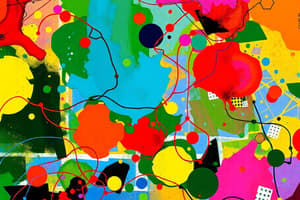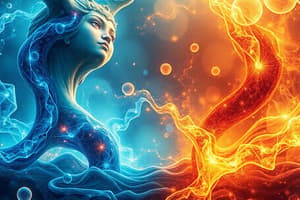Podcast
Questions and Answers
In the reaction between mercury(II) oxide and carbon, which species undergoes oxidation and which undergoes reduction?
In the reaction between mercury(II) oxide and carbon, which species undergoes oxidation and which undergoes reduction?
Mercury undergoes oxidation, while carbon undergoes reduction.
What is the product of the hydrogen-atom transfer reaction between hydrazine and oxygen?
What is the product of the hydrogen-atom transfer reaction between hydrazine and oxygen?
The products are molecular nitrogen and water.
Explain the electron transfer in the reaction between zinc metal and copper(II) ion.
Explain the electron transfer in the reaction between zinc metal and copper(II) ion.
Zinc metal transfers two electrons to the copper(II) ion.
Why is understanding redox reactions essential in science and industry?
Why is understanding redox reactions essential in science and industry?
How do redox reactions demonstrate the reciprocal nature of oxidation and reduction?
How do redox reactions demonstrate the reciprocal nature of oxidation and reduction?
What is the role of redox reactions in chemistry?
What is the role of redox reactions in chemistry?
Define oxidation and reduction in the context of redox reactions.
Define oxidation and reduction in the context of redox reactions.
Explain the changes in oxidation state of the oxidizing and reducing agents in a redox reaction.
Explain the changes in oxidation state of the oxidizing and reducing agents in a redox reaction.
What are the three main types of redox reactions?
What are the three main types of redox reactions?
Provide an example of an oxygen-atom transfer reaction.
Provide an example of an oxygen-atom transfer reaction.
Flashcards are hidden until you start studying
Study Notes
Understanding Redox Reactions
Redox reactions, short for reduction-oxidation reactions, are a fundamental aspect of chemistry. They involve the transfer of electrons between chemical species, leading to a change in the oxidation state of the species involved. These reactions play a crucial role in various natural and industrial processes such as photosynthesis, cellular respiration, combustion, and corrosion of metals.
In a redox reaction, one species undergoes oxidation, which is the loss of electrons, while another species undergoes reduction, which is the gain of electrons. The oxidizing agent, the species that loses electrons, becomes more positive in its oxidation state, while the reducing agent, the species that gains electrons, becomes more negative in its oxidation state. This change in oxidation state allows chemists to predict the outcome of a reaction based on the initial oxidation state of the species involved.
There are three main types of redox reactions: oxygen-atom transfer, hydrogen-atom transfer, and electron transfer. Each of these types encompasses reactions where oxidation and reduction occur simultaneously, often through the transfer of electrons between species.
Oxygen-Atom Transfer
In oxygen-atom transfer reactions, oxygen atoms are transferred from one species to another. A classic example is the reaction between carbon and mercury(II) oxide, where mercury metal is formed along with carbon dioxide. Here, the mercury atom in mercury(II) oxide gives up one oxygen atom to form mercury metal, and the carbon atom takes up two oxygen atoms to form carbon dioxide. This process illustrates a reciprocal relationship between oxidation and reduction, where the loss of oxygen atoms (oxidation in the case of mercury) leads to the gain of oxygen atoms (reduction in the case of carbon).
Hydrogen-Atom Transfer
Hydrogen-atom transfer reactions involve the transfer of hydrogen atoms between species. An example is the reaction between hydrazine and oxygen, where molecular nitrogen and water are produced. In this reaction, hydrazine loses hydrogen atoms, forming molecular nitrogen, while oxygen gains hydrogen atoms to form water. Again, we see the reciprocal nature of oxidation and reduction, with one species experiencing oxidation (hydrazine) and another undergoing reduction (oxygen).
Electron Transfer
Electron transfer reactions are characterized by the direct transfer of electrons between species. An illustrative example is the reaction between zinc metal and copper(II) ion, where copper metal and an aqueous zinc ion are formed. Here, zinc metal transfers two electrons to the copper(II) ion, resulting in the formation of copper metal. Conversely, the copper(II) ion gains two electrons, ultimately leading to the production of the aqueous zinc ion.
Understanding redox reactions is essential for various applications in science and industry, including electrochemistry, battery development, and environmental sustainability. By studying and manipulating these reactions, scientists can design new materials, develop efficient energy storage systems, and address pressing issues related to pollution and climate change.
Studying That Suits You
Use AI to generate personalized quizzes and flashcards to suit your learning preferences.




